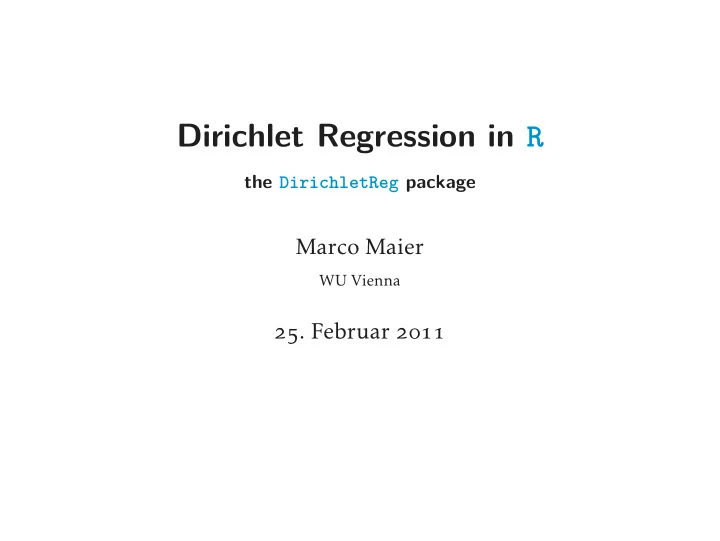

Dirichlet Regression in R the DirichletReg package Marco Maier WU Vienna . Februar
COMPOSITIONAL DATA . . . 1 Compositional Data . . . are composed of a set of variables whose contents are in a certain interval and sum up to a constant for each observation, e.g. the composition of the sediments in a lake which could be partitioned in sand, silt, and clay: obs. sand silt clay � . . . . . . . . . . . . . . . . . . . . . i y i y i y i y i + . . . . . . . . . . . . . . . Because of the constraint, any variable can be omitted and represented by y j = − � y i . i � j Compositional data reflect – as the name suggests – the ‘compositional structure’ of so- mething across all variables. It can be applied in fields as diverse as medicine (toxins etc. in blood samples), geology, psychology, . . . .
COMPOSITIONAL DATA . . . As the beta distribution is the continuous version of the binomial dist., the Dirichlet dist. is a continuous multinomial distribution. This allows for nominal items without coercing respondents to select only one category, e.g.: Which party would you vote for? Grüne SPÖ ÖVP FPÖ multinomial Dirichlet . . . If the ‘probability’ of answering in a certain cateogory is spread across the choices, a Di- richlet approach is more informative. This package aims at implementing a Dirichlet-regression using two di ff erent paramete- rizations along with a strong focus on graphical representation of the data and models, model tests and model selection.
THE DIRICHLET DISTRIBUTION 2 The Dirichlet Distribution The Dirichlet distribution is a generalization of the beta dist. for more than variables (of which one is usually omitted, because it is redundant; y = − y and vice versa). These k variables have to lie in the interval ( , ) and sum up to for each observation. k � y α i − f( y | α ) = ( ) B( α ) i i = Normalization is provided by B( α ), the multinomial beta-function, which can be expres- sed as: � k i = Γ ( α i ) B( α ) = ( ) Γ ( � k i = α i ) Each component is governed by a shape parameter α > which are in and of itself not very informative. Their sum α = � i α i can be interpreted as a ‘precision parameter’.
THE DIRICHLET DISTRIBUTION With this precision parameter, we can calculate the means E( y i ) = α i α and also the variances VAR( y i ) = α i ( α − α i ) α ( α + ) and covariances of the variables − α i α j COV( y i ,y j ) = ( α + ); i � j α
Recommend
More recommend